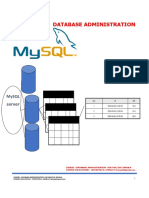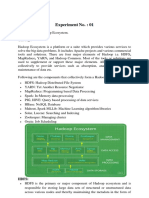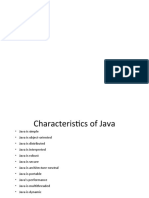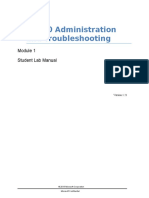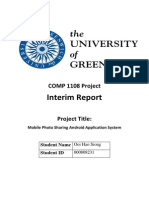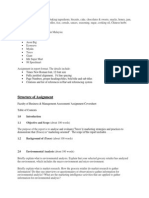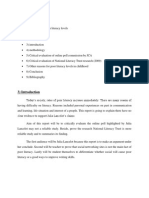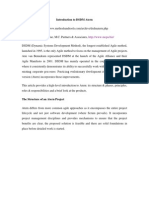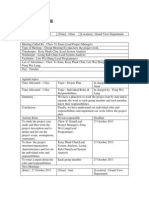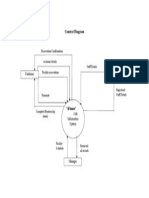Professional Documents
Culture Documents
Introduction of Oracle Solaris Operating System
Uploaded by
Yexeon ChewOriginal Description:
Copyright
Available Formats
Share this document
Did you find this document useful?
Is this content inappropriate?
Report this DocumentCopyright:
Available Formats
Introduction of Oracle Solaris Operating System
Uploaded by
Yexeon ChewCopyright:
Available Formats
Introduction of Oracle Solaris Operating System Solaris is the computer operating system that Sun Microsystems provides for
its family of Scalable Processor Architecture-based processors as well as for Intel-based processors. Sun has historically dominated the large UNIX workstation market. As the Internet grew in the early 1990s, Sun's SPARC/Solaris systems became the most widely installed servers for Web sites. Sun emphasizes the system's availability (meaning it seldom crashes), its large number of features, and its Internet-oriented design. Sun advertises that its latest version, the Solaris 8 Operating Environment, is "the leading UNIX environment" today. Overview of Oracle Solaris Operating System Solaris is a Unix operating system originally developed by Sun Microsystems. It superseded their earlier SunOS in 1993. Oracle Solaris, as it is now known, has been owned by Oracle Corporation since Oracle's acquisition of Sun in January 2010. In 1987, AT&T and Sun announced that they were collaborating on a project to merge the most popular Unix variants on the market at that time: BSD, System V, and Xenix. This became Unix System V Release 4 (SVR4). On September 4, 1991, Sun announced that it would replace its existing BSD-derived Unix, SunOS 4, with one based on SVR4. This was identified internally as SunOS 5, but a new marketing name was introduced at the same time: Solaris 2.While SunOS 4.1.x micro releases were retroactively named Solaris 1 by Sun, the Solaris name is almost exclusively used to refer to the SVR4-derived SunOS 5.0 and later. The justification for this new "overbrand" was that it encompassed not only SunOS, but also the OpenWindows graphical user interface and Open Network Computing (ONC) functionality. The SunOS minor version is included in the Solaris release number; for example, Solaris 2.4 incorporated SunOS 5.4. After Solaris 2.6, Sun dropped the "2." from the number, so Solaris 7 incorporates SunOS 5.7, and the latest release SunOS 5.11 forms the core of Solaris 11.
Brief History of Oracle Solaris Operating System
Features & Capability & Roles & Characteristics & Key Differentiators of Oracle Solaris Operating System (1.) Symmetric multiprocessing Solaris is implemented on systems ranging from single-processor systems to 64-processor symmetric multiprocessor servers. Solaris provides linear scalability up to the currently supported maximum of 64 processors. (2.) 64-bit kernel and process address space A 64-bit kernel for 64-bit platforms provides an LP64 execution environment. (LP64 refers to the data model: long and pointer data types are 64 bits wide.) A 32-bit application environment is also provided so that 32bit binaries execute on a 64-bit Solaris kernel alongside 64-bit applications. (3.) Multiple platform support Solaris supports a wide range of SPARC and Intel x86 microprocessor-based architectures. A layered architecture means that over 90 percent of the Solaris source is platform independent. (4.) Modular binary kernel The Solaris kernel uses dynamic linking and dynamic modules to divide the kernel into modular binaries. A core kernel binary contains central facilities; device drivers, file systems, schedulers, and some system calls are implemented as dynamically loadable modules. Consequently, the Solaris kernel is delivered as a binary rather than source and object, and kernel compiles are not required upon a change of parameters or addition of new functionality. (5.) Multithreaded process execution A process can have more than one thread of execution, and these threads can run concurrently on one or more processors. Thus, a single process can use multiple processors for concurrent thread execution, thereby using multiprocessor platforms more efficiently. (6.) Multithreaded kernel The Solaris kernel uses threads as the entity for scheduling and execution: The kernel schedules interrupts and kernel services as regular kernel threads. This key feature provides interrupt scalability and low-latency interrupt response.
Previous UNIX implementations manipulated processor priority levels to ensure exclusive access to critical interrupt data structures. As a result, the inability of interrupt code to block led to poor scalability. Solaris provides greater parallelism by scheduling interrupts as threads, which can then use regular kernel locks to ensure exclusive access to data structures. (7.) Fully preemptable kernel The Solaris kernel is fully preemptable and does not require manipulation of hardware interrupt levels to protect critical datalocks synchronize access to kernel data. This means threads that need to run can interrupt another, lower-priority thread; hence, low latency scheduling and low latency interrupt dispatch become possible. For example, a process waking up after sleeping for a disk I/O can be scheduled immediately, rather than waiting until the scheduler runs. Additionally, by not raising priority levels and blocking interrupts, the system need not periodically suspend activity during interrupt handling, so system resources are used more efficiently. (8.) Support for multiple schedulers Solaris provides a configurable scheduler environment. Multiple schedulers can operate concurrently, each with its own scheduling algorithms and priority levels. Schedulers are supplied as kernel modules and are dynamically loaded into the operating system. Solaris offers a table-driven, usage-decayed, timesharing user scheduler (TS); a window system optimized timeshare scheduler (IA); and a real-time fixed priority scheduler (RT). An optional fair-share scheduler class can be loaded with the Solaris Resource Manager package. (9.) Support for multiple file systems Solaris provides a virtual file system (VFS) framework that allows multiple file systems to be configured into the system. The framework implements several disk-based file systems (UNIX File System, MS-DOS file system, CD-ROM file system, etc.) and the network file system (NFS V2 and V3). The virtual file system framework also implements pseudo file systems, including the process file system, procfs, a file system that abstracts processes as files. The virtual file system framework is integrated with the virtual memory system to provide dynamic file system caching that uses available free memory as a file system cache.
(10.) Processor partitioning and binding Special facilities allow fine-grained processor control, including binding processes to processors. Processors can be configured into scheduling groups to partition system resources. (11.) Demand-paged virtual memory system This feature allows systems to load applications on demand, rather than loading whole executables or library images into memory. Demand-paging speeds up application startup and potentially reduces memory footprint. (11.) Modular virtual memory system The virtual memory system separates virtual memory functions into distinct layers; the address space layer, segment drivers, and hardware-specific components are consolidated into a hardware address translation (HAT) layer. Segment drivers can abstract memory as files, and files can be memory-mapped into an address space. Segment drivers enable different abstractions, including physical memory and devices, to appear in an address space. (11.) Modular device I/O system Dynamically loadable device and bus drivers allow a hierarchy of buses and devices to be installed and configured. A device driver interface (DDI) shields device drivers from platform-specific infrastructure, thus maximizing portability of device drivers. (12.) Integrated networking With the data link provider interface (DLPI), multiple concurrent network interfaces can be configured, and a variety of different protocols including Ethernet, X.25, SDLC, ISDN, FDDI, token bus, bi-sync, and other datalink-level protocolscan be configured upon them. (13.) Integrated Internet protocol Solaris implements TCP/IP by use of the DLPI interfaces. (14.) Real-time architecture The Solaris kernel was designed and implemented
to provide real-time capabilities. The combination of the preemptive kernel, kernel interrupts as threads, fixed priority scheduling, high-resolution timers, and fine-grained processor control makes Solaris an ideal environment for real-time applications. Structure & Architecture of Oracle Solaris Operating System Kernel Overview The Solaris kernel is the core of Solaris. It manages the system hardware resources and provides an execution environment for user programs. The Solaris kernel supports an environment in which multiple programs can execute simultaneously. The primary functions of the kernel can be divided into two major categories: managing the hardware by allocating its resources among the programs running on it; and supplying a set of system services for those programs to use. Solaris Kernel Architecture (1.) System Call Interface The system call interface allows user processes to access kernel facilities. The system call layer consists of a common system call handler, which vectors system calls into the appropriate kernel modules. (2.) Process Execution and Scheduling Process management provides facilities for process creation, execution, management, and termination. The scheduler implements the functions that divide the machines processor resources among threads on the system. The scheduler allows different scheduling classes to be loaded for different behavior and scheduling requirements. (4.) Memory Management The virtual memory system manages mapping of physical memory to user processes and the kernel. The Solaris memory management layer is divided into two layers: the common memory management functions and the hardware-specific components. The hardware-specific components are located in the hardware address translation (HAT) layer.
(5.) File Systems Solaris implements a virtual file system framework, by which multiple types of file system can be configured into the Solaris kernel at the same time. Regular disk-based file systems, network file systems, and pseudo file systems are implemented in the file system layer. (6.) I/O Bus and Device Management The Solaris I/O framework implements bus nexus node drivers (bus-specific architectural dependencies, e.g., a PCI bus) and device drivers (a specific device on a bus, e.g., an Ethernet card) as a hierarchy of modules, reflecting the physical layout of the bus/device interconnect. (7.) Kernel Facilities (Clocks, timers, etc.) Central kernel facilities, including regular clock interrupts, system timers, synchronization primitives, and loadable module support. (8.) Networking TCP/IP protocol support and related facilities. The Solaris networking subsystem is implemented as streams-based device drivers and streams modules. Solaris Components
Pros & Advantages & Strength of Oracle Solaris Operating System
(1.) First OS for clouds. Fast, intelligent provisioning capabilities for rapid service setup and maintenance. Oracle Solaris ZFS makes creating multiple images simple and highly efficient. (2.) Built-in virtualization in every dimension. Fully virtualized networking features for the highest levels of performance with the lowest overhead, adding even more flexibility to Oracle Solaris Zones. Secure live migration with Oracle VM for SPARC and x86. (3.) Improved data management. The industry-leading Oracle Solaris ZFS technology moves yet further ahead with new advanced storage features such as built-in deduplication, encryption, and thin provisioning. The best storage foundation for traditional, virtualized and cloud environments. (4.) Advanced security. Fully integrated security for users, applications, and devices while simplifying administration with fine-grained delegated management, implementing the latest security standards and continuing Oracle Solaris' leadership position as a highly secure operating system. (5.) Virtualization. Optimize resource utilization to deliver predictable service levels with Oracle Solaris Containers. (6.) Networking. Attain near-wire-speed throughput with minimal CPU overhead using the Oracle Solaris networking stack. (7.) Security. Implement a secure foundation for deploying services with Oracle Solaris leading-edge security features. (8.) Availability. Minimize unplanned downtime with the predictive self healing feature. . Cons & Disadvantages of Oracle Solaris Operating System Disadvantages:
(1.) Uncompatible : It is not recommended to run Solaris on other architectures such as Intel, AMD. It is possible to install Solaris on Intel however, the performance would degrade considerably since Solaris cannot make use of Intel that efficiently. (2.) Lack of good GUI : Solaris does have GUI support - Common Desktop Environment, OpenWindows etc. but they are far way from the other GUI environments seen in Windows or Mac. (3.) Costlier : With other cheaper alternatvies such as Linux available, it proves to be costlier to acquire a license of Solaris. Since it is intended to be used on SPARC so the end user often ends up in buying the hardware as well. (4.) PAM availability and capabilities are lacking in comparison with Linux. Ports of most interesting linux PAM modules is long overdue. Despite pioneering the concept Solaris in now lags behind Linux in this area. (5.) Availability of productivity enhancing command line tools, especially orthodox file managers is lower. For example, Midnight Commander essentially became linux only application and works not so well on Solaris. Prepackaged version of deco and other lightweight OFMs are difficult to find. (6.) Packaging is weaker. It can be considered completely outdated although there are rumors that Sun is taking steps in adopting apt-get. (7.) Support from third party vendors for key enterprise applications is weakening as Oracle is flirting with Linux and IBM also promotes Tivoli and other key enterprise applications for Linux and AIX. Still Solaris on Sparc has about 12,000 enterprise applications, and the porting job from Solaris on Sparc to Solaris on X86 is a lot easier than moving from Solaris to Red Hat Linux. Tools of Oracle Solaris Operating System Oracle Solaris 10
Oracle Solaris 10 is the strategic platform for todays demanding enterprise, delivering proven results on everything from missioncritical enterprise databases to high-performance Web farms, and from the latest generation of symmetric multiprocessing (SMP) SPARC systems to industry-standard x86 systems. For customers facing challenging business and technical requirementssuch as lowering costs, simplifying system administration, and maintaining high service levelsOracle Solaris 10 is the ideal cross-platform choice
Oracle Solaris 11 Oracle Solaris 11 builds on the proven technologies of the industrys UNIX, and adds new technologies designed to accelerate adoption of enterprise scale workloads in public, private and hybrid cloud environments. Oracle Solaris 11 is supported on hundreds of SPARC and x86 platforms, including Oracles Exadata, Exalogic and SPARC SuperCluster engineered systems.
Oracle Solaris Cluster Enterprises are increasingly looking at cloud infrastructures to manage cost and increase deployment flexibility. Most workloads deployed today are non mission critical. To deploy
mission critical applications in the cloud requires a new set of capabilities, which ensure security, scalability, and reliability for deployment, management, and protection of business services. Oracle Solaris 11, the first cloud OS, delivers innovative technologies designed for a solid cloud services foundation. Oracle Solaris Cluster extends the Oracle Solaris high availability and disaster recovery capabilities to deliver the next generation mission-critical cloud.
Oracle Solaris Studio Oracle Solaris Studio is the development toolsuite for building C, C++ and Fortran applications for Oracle Solaris and Linux operating systems. Oracle Solaris Studio is optimized for Oracle Sun Systems (SPARC and x86) and offers an advanced integrated toolset that leverages system features, enabling developers to build high-performance scalable and reliable applications faster.
Type of the version of Oracle Solaris Operating System
Differentiate & Comparison Oracle Solaris Operating System with other OS
Conclusion
All-in-all Solaris is powerful, stable, conformant to standards OS that can run many open source applications as well as Linux and some (mainly multithreaded applications) better then Linux. Solaris 10 is probably the most close to Linux flavor of enterprise Unix and as such is preferable in enterprise Unix flavors cocktails to AIX and HP-UX due to broader commonality of administration between those two OSes (which might increase even more due to recent Sun moves of created Linux personality for Solaris and Oracle acquisition of Sun). References
You might also like
- Open Solaris General Case StudyDocument66 pagesOpen Solaris General Case StudySudantha SulochanaNo ratings yet
- Teacher's Notes - Lab Chapter 1 - Intro To SolarisDocument3 pagesTeacher's Notes - Lab Chapter 1 - Intro To SolarisFrancisEmmanuelGonzagaNo ratings yet
- SolarisDocument62 pagesSolarisPro Loop0% (1)
- Solaris Memory ManagementDocument35 pagesSolaris Memory ManagementTech_MXNo ratings yet
- Memory Management in SolarisDocument4 pagesMemory Management in Solarisjohnmerc1234No ratings yet
- Introduction To Linux CommandsDocument62 pagesIntroduction To Linux CommandsHardik Garg100% (1)
- Solaris Process ManagementDocument11 pagesSolaris Process ManagementSelva Kumar SK100% (1)
- System Initialization & ShutdownDocument13 pagesSystem Initialization & ShutdownFaisal Sikander KhanNo ratings yet
- Architecture of The Linux Operating SystemDocument3 pagesArchitecture of The Linux Operating Systemharshalwarke1991No ratings yet
- Linux Operatig SystemDocument20 pagesLinux Operatig SystemGursharan Singh AnamikaNo ratings yet
- VB NotesDocument14 pagesVB NotesGachagua Lastborn50% (2)
- SQLDocument11 pagesSQLindiraamrNo ratings yet
- Development of Computer LanguagesDocument6 pagesDevelopment of Computer LanguagesSyedAsjadAliNo ratings yet
- Case StudyDocument7 pagesCase StudyÀüsåf MûghãlNo ratings yet
- Unix Full NotesDocument52 pagesUnix Full NotesRahul SinhaNo ratings yet
- 000 025 PDFDocument45 pages000 025 PDFtareqcccccNo ratings yet
- CS430 Solaris and DTrace PresentationDocument8 pagesCS430 Solaris and DTrace PresentationChris HartNo ratings yet
- Managing Users, Groups and File Permissions: Linux Platform - IDocument27 pagesManaging Users, Groups and File Permissions: Linux Platform - IfdsaaNo ratings yet
- Backup and Restore Ms SQL ServerDocument13 pagesBackup and Restore Ms SQL ServerAl MamunNo ratings yet
- 2 - Process ManagementDocument143 pages2 - Process ManagementThanh HoàngNo ratings yet
- Unit 1Document8 pagesUnit 1rajeswarikannanNo ratings yet
- Fundamentals of InternetDocument31 pagesFundamentals of InternetYogendra Singh ChaharNo ratings yet
- Routing and Switching Slides - 1Document305 pagesRouting and Switching Slides - 1Jaime GomezNo ratings yet
- Android NotesDocument24 pagesAndroid NotesAdit KadakiaNo ratings yet
- 9.2 Desirable Features of Good Distributed File SystemDocument20 pages9.2 Desirable Features of Good Distributed File SystemAbitha DNo ratings yet
- Lab-1 Introduction To Java - 1148858255Document27 pagesLab-1 Introduction To Java - 1148858255Rohit SinghNo ratings yet
- 2.3 Managing User and GroupDocument12 pages2.3 Managing User and GroupmeshNo ratings yet
- Operatingsystems Concepts Silberschatzgalvinslides 130228082901 Phpapp01Document538 pagesOperatingsystems Concepts Silberschatzgalvinslides 130228082901 Phpapp01Kashish NagpalNo ratings yet
- DataBase AdministrationDocument50 pagesDataBase AdministrationHelp me get to 10k subscribersNo ratings yet
- Solaris 10 Quick Reference BasicDocument3 pagesSolaris 10 Quick Reference Basicjalav100% (7)
- Open RHCEDocument129 pagesOpen RHCEenter510% (1)
- Java 3 Years Experience ResumeDocument3 pagesJava 3 Years Experience ResumeKishore MutcharlaNo ratings yet
- Linux Final Notes PDFDocument211 pagesLinux Final Notes PDFFayaz AhmedNo ratings yet
- Linux Firewalls PPT 4205Document80 pagesLinux Firewalls PPT 4205Mukul JhaNo ratings yet
- Linux FundamentalsDocument4 pagesLinux FundamentalsPratham MishraNo ratings yet
- Red Hat Enterprise LinuxDocument36 pagesRed Hat Enterprise LinuxNelum Narmada DewapuraNo ratings yet
- Course File CSE 6th Sem DAADocument91 pagesCourse File CSE 6th Sem DAAbias bhadraNo ratings yet
- 01 Introduction To JavaDocument38 pages01 Introduction To JavaAtheena Danielle DumagoNo ratings yet
- Exp# 1a Fork System Call Aim: CS2257 Operating System LabDocument3 pagesExp# 1a Fork System Call Aim: CS2257 Operating System LabAbuzar ShNo ratings yet
- CSCP 363: Object Oriented Programming in Java IDocument21 pagesCSCP 363: Object Oriented Programming in Java IOperation ResearchNo ratings yet
- Chapter-1 Background and Some Basic Commands: 1) Explain Salient Features of UNIX System? Explain All BrieflyDocument30 pagesChapter-1 Background and Some Basic Commands: 1) Explain Salient Features of UNIX System? Explain All BrieflyLoli BhaiNo ratings yet
- Hitachi VSP G1000 ALUA SupportDocument23 pagesHitachi VSP G1000 ALUA Supportsudheer910No ratings yet
- Dileep Kumar: #1: Encrypt Data CommunicationDocument8 pagesDileep Kumar: #1: Encrypt Data Communicationkumar184No ratings yet
- BDA Experiment 14 PDFDocument77 pagesBDA Experiment 14 PDFNikita IchaleNo ratings yet
- Most Expected 2 Marks Most Expected Questions Stack Computer Science Class 12Document28 pagesMost Expected 2 Marks Most Expected Questions Stack Computer Science Class 12sridharan.sri7766No ratings yet
- Introduction To Java Programming: Ashwinth.J Anna University ChennaiDocument79 pagesIntroduction To Java Programming: Ashwinth.J Anna University ChennaiAshwinth Janarthanan MenonNo ratings yet
- Unix NotesDocument39 pagesUnix NotesVivek PawarNo ratings yet
- History of AJAXDocument18 pagesHistory of AJAXraghuraman36No ratings yet
- Linux Manage User GroupDocument25 pagesLinux Manage User GroupJoel MinaNo ratings yet
- IIS 8.0 Administration and Troubleshooting: Student Lab ManualDocument16 pagesIIS 8.0 Administration and Troubleshooting: Student Lab ManualElizandro SantosNo ratings yet
- UNIX & SHELL ProgrammingDocument3 pagesUNIX & SHELL Programmingaskamn100% (1)
- Solaris MemoryDocument12 pagesSolaris MemorySuresh SadasivanNo ratings yet
- Linux - CentOS System Administrator PrepDocument4 pagesLinux - CentOS System Administrator PrepZoltan LedererNo ratings yet
- SolarisDocument15 pagesSolarisJoshua BolasaNo ratings yet
- Interim Report: COMP 1108 ProjectDocument4 pagesInterim Report: COMP 1108 ProjectYexeon ChewNo ratings yet
- Structure of Assignment: 1.0 1.1 Objective and Scope (About 100 Words)Document7 pagesStructure of Assignment: 1.0 1.1 Objective and Scope (About 100 Words)Yexeon ChewNo ratings yet
- Interim Report: COMP 1108 ProjectDocument4 pagesInterim Report: COMP 1108 ProjectYexeon ChewNo ratings yet
- IntroductionDocument11 pagesIntroductionYexeon ChewNo ratings yet
- Interim Report: COMP 1108 ProjectDocument4 pagesInterim Report: COMP 1108 ProjectYexeon ChewNo ratings yet
- Introduction To DSDM AternDocument13 pagesIntroduction To DSDM AternYexeon ChewNo ratings yet
- COMP1549 Advanced Programming Exam1213Document13 pagesCOMP1549 Advanced Programming Exam1213Yexeon ChewNo ratings yet
- To Start (Hand Out To The Lecturer) : Marks Will Be Allocated)Document3 pagesTo Start (Hand Out To The Lecturer) : Marks Will Be Allocated)Yexeon ChewNo ratings yet
- CV - Chew Yi XuanDocument2 pagesCV - Chew Yi XuanYexeon ChewNo ratings yet
- COMP1632 - Information System Development Project (ISDP) : Coursework 2 - Individual ReportDocument6 pagesCOMP1632 - Information System Development Project (ISDP) : Coursework 2 - Individual ReportYexeon ChewNo ratings yet
- Minute of MeetingDocument10 pagesMinute of MeetingYexeon Chew100% (1)
- Introduction of Oracle Solaris Operating SystemDocument21 pagesIntroduction of Oracle Solaris Operating SystemYexeon ChewNo ratings yet
- Context Diagram: Staff CustomerDocument1 pageContext Diagram: Staff CustomerYexeon ChewNo ratings yet
- Segi College Penang Business Research "The Research On The Importance of Using Mobile Phone Among Diploma Students in Segi College Penang."Document9 pagesSegi College Penang Business Research "The Research On The Importance of Using Mobile Phone Among Diploma Students in Segi College Penang."Yexeon ChewNo ratings yet
- COMP1631 - Information Analysis: CourseworkDocument1 pageCOMP1631 - Information Analysis: CourseworkYexeon ChewNo ratings yet
- GSCDocument6 pagesGSCYexeon ChewNo ratings yet
- Segi Learning Management SystemDocument2 pagesSegi Learning Management SystemYexeon ChewNo ratings yet
- Data Flow Diagram 0-Level DFD: Response View 0Document2 pagesData Flow Diagram 0-Level DFD: Response View 0Yexeon ChewNo ratings yet


































